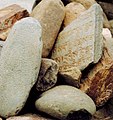Manistein
In the popular belief of Tibetan Buddhism, a manistein ( Tibetan rdo ma ni ) is a stone decorated with sacred texts or traditional prayer formulas as an offering.
Mani stones and mani stone heaps / walls
|
Mani stones are engraved or inscribed, often palm-sized stones or larger stone slabs. They are left by pilgrims in the area of temples , stupas , chortas and monasteries , but also sacred places such as pass heights and at crossroads. Simple mani stones are often labeled with “ Om mani padme hum ”, larger ones are also provided with images of Buddha, animals or saints.
Over time, high layered arise in this way long Manisteinhaufen and Manisteinmauern or embankments (Tibetan ma rdo ni'i phung ; Chinese嘛呢堆Mani dui ; also嘛呢墙Mani qiang ,嘛呢城Manicheng ), which also clean can be worked out as masonry.
Examples
Some mani stone walls are on the list of monuments of the People's Republic of China : the largest is Gyanak Mani in Xinzhai in Yushu County in Qinghai Province . Also famous are those of the Hor Monastery in the village of Hor in the Zêkog district in the east of the Chinese province of Qinghai, also the Songge Manisteinwall and the Bage Manisteinwall in the Sêrxü district in the northwest of Sichuan , as well as those of the Bangtuo Monastery in the Zamtang District (or Dzamthang; Chinese Rangtang ) of the Ngawa Autonomous District of the Tibetans and Qiang in northern Sichuan.
Manistein in Ladakh
Manistein in Zanskar
Mani Wall in Vienna ( Druk-Yul-Park , 2012)
Reception in the arts
In the modern Tibetan feature film Stille Manisteine (Tibetan Lhing vjags kyi ma ni rdo vbum ) by Pema Tseden (Wanma Caidan), in which the ancient beliefs of Tibetans are confronted with images from modern telecommunications, Manisteine can be seen at the beginning.
See also
- Cairn
- Mani wheel (prayer wheel )
- Prayer flag
literature
- Zangzu da cidian. Lanzhou 2003 (Mani shi; Mani dui).
Web links
- Mani Stones (English).
- Ladakh Hundar: Mani walls (Bernhard Peter).
- Mani dui (Chinese).
- Bage Mani Wall (English).
- Video: Bage Mani qiang. In: tvtour.com.cn. 2004, accessed June 20, 2014 (2.5 minutes; Chinese video of the Bage Manistein Wall in the Sêrxü Tibetan district of Sichuan Province).
Individual evidence
- ↑ Lexicon entry: Manisteine. ( Memento from November 12, 2011 in the Internet Archive ) In: Wissen.de . Retrieved August 8, 2020.
- ↑ Chinese 和 日 乡Heri xiang .
- ↑ The stone carvings of the Hor Monastery are on the list of the intangible cultural heritage of the People's Republic of China (VII-56).
- ↑ Chinese 棒 托 寺 Bangtuo si .
- ↑ Chinese 静静 的 嘛呢 石; engl. The Silent Holy Stones
- ↑ The filmmaker in conversation ; Interview accessed on January 4, 2011.
- ↑ Excerpts from youtube.com (1:26), tudou.com (29:35), accessed on January 4, 2011.






